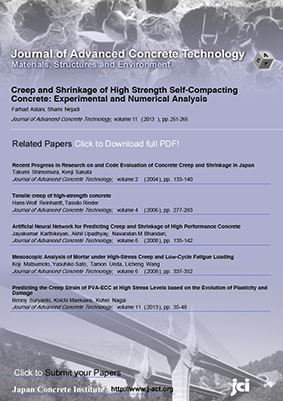
- |<
- <
- 1
- >
- >|
-
Piotr Dybeł, Daniel Wałach, Krzysztof Ostrowski2018 年 16 巻 7 号 p. 282-292
発行日: 2018/07/13
公開日: 2018/07/13
ジャーナル フリーAn investigation of the steel-to-concrete bond in high-performance self-compacting concrete (HPSCC) is presented based on direct pull-out tests. The investigation was performed on specimens made of three different HPSCC mixes with varying contents of silica fume (without, 5 and 10% by mass of cement). Specifically, the top-bar effect in specimens with a single casting point at one edge was examined. Horizontal specimens with transverse rebars distributed over their heights (480 mm) and lengths (1600 mm) were cast. The bond capacity of the HPSCC was decreased across the length up to the measured rebar distance from the casting point. The reduction occurred with the same magnitude in both the lower and upper section of the horizontal specimens. It was found that the top-bar effect did not change significantly with an increasing distance of the rebars from the casting point of the concrete mixture. It was demonstrated that the modification of the HPSCC using the silica fume significantly improved the quality of the bond conditions.
抄録全体を表示PDF形式でダウンロード (2922K)
-
Hamed Taghvayi, Kiachehr Behfarnia, Mohammadbagher Khalili2018 年 16 巻 7 号 p. 293-305
発行日: 2018/07/13
公開日: 2018/07/13
ジャーナル フリーIn this study, the effect of alkali concentration and sodium silicate modulus of the activator solution on workability, compressive strength, and drying shrinkage of alkali-activated slag (AAS) concrete was investigated experimentally. Twenty mixes were prepared with the ground granulated blast furnace slag (GGBFS) activated with the various alkali concentrations and sodium silicate modulus. The compressive strength at the ages of 7, 28 and 90 days was measured and the drying shrinkage of the concrete samples up to 400 days were measured. Based on the results, in most mixes, by increasing the sodium silicate modulus and the concentration of the alkali solution, the slump, compressive strength, and the rate of the drying shrinkage of the samples were increased, but the setting time was reduced. These results were contrary to those specimens cast with high alkalinity. The effect of the sodium silicate modulus was much higher than the concentration of the alkali solution on the drying shrinkage of the samples. In order to evaluate the effect of the alkali concentration and the silicate modulus on the microstructure and the reaction product of the AAS paste, x-ray diffraction (XRD) analysis and scanning electron microscopy (SEM) images were examined.
抄録全体を表示PDF形式でダウンロード (2165K) -
Jiahe Wang, Jun Zhang, Jiajia Zhang2018 年 16 巻 7 号 p. 306-316
発行日: 2018/07/26
公開日: 2018/07/27
ジャーナル フリーIn the present paper, adiabatic temperature rise test was used to evaluate the effect of internal curing on cement hydra-tion rate and final degree of hydration in normal and high strength concretes. In the experiments, emphases were placed on the impacts of internal curing and water to cementitious material ratio on the adiabatic temperature rise characteristics. Two kinds of concrete, ordinarily cured concrete and internally cured concrete were used in the experiments. In each kind, four concrete mixtures with water to cementitious material ratios of 0.20, 0.30, 0.43 and 0.62 were used. The test results show that internal curing with PSLWA increases temperature rise of concrete, whatever the con-crete strength is low or high. Internal curing can not only increase the ultimate temperature rise, but also increase the rate of temperature rise. Internal curing can obviously improve the cement hydration behavior compared with the concrete without internal curing. The improvements on cement hydration may present in two. One is the hydration rate in the second stage is increased; another is the final cement hydration degree is increased. For internally cured concrete, the water used to calculate the water to binder ratio can be simply summing the mixing water and internal curing water together when calculate the final cement hydration degree. The proposed cement hydration rate model can well predict developing of cement hydration degree for both ordinarily and internally cured concretes.
抄録全体を表示PDF形式でダウンロード (1808K)
- |<
- <
- 1
- >
- >|